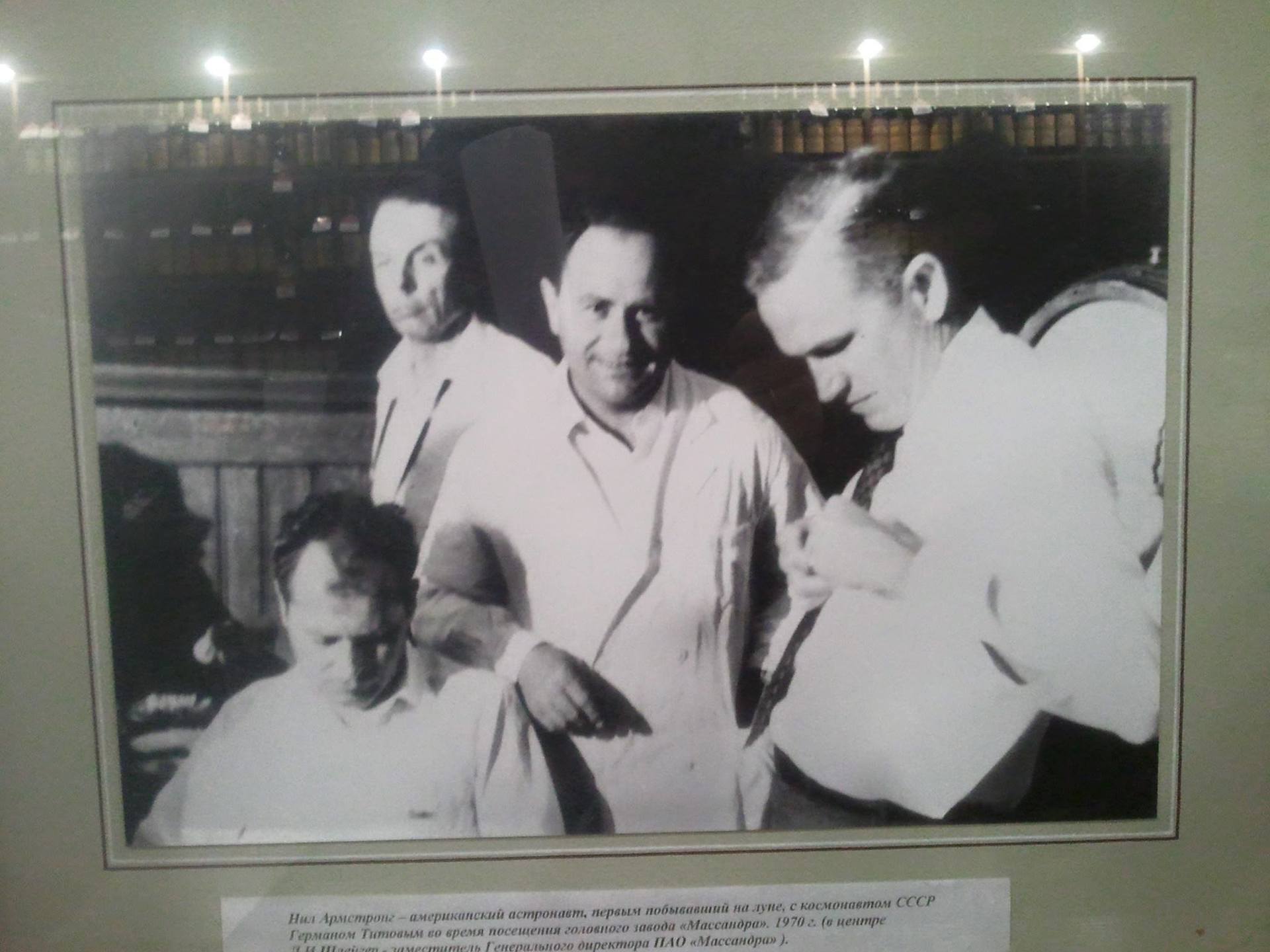Little secret artist Alexei Leonov
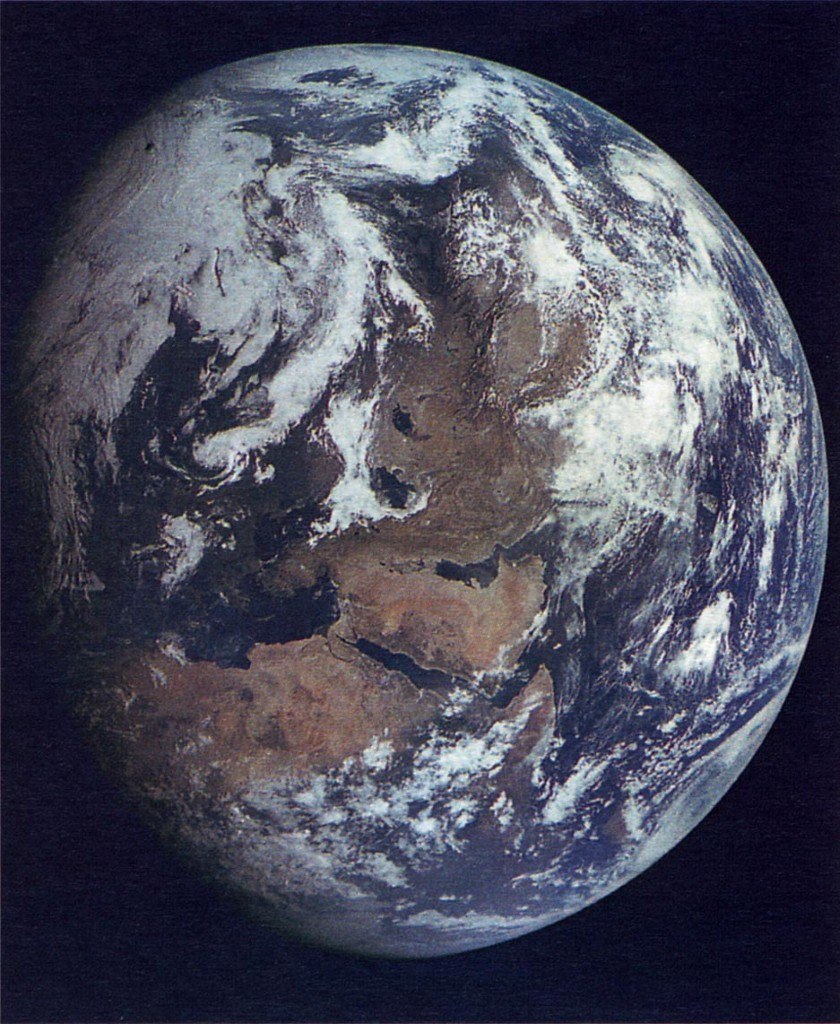 Half-truth is true for the uninitiated. Yu.M. Nagibin
Half-truth is true for the uninitiated. Yu.M. NagibinWhat am I talking about? I like to read memoirs, in recent years, most often, on a space theme. After a certain number of books read, enough information accumulates to see the same events through the eyes of different people. And then
/**
Это только кат. Здесь не заканчивается длинное вступление, которое-не-планировалось.
Осторожно - много букв.
*/Who made a mistake, who quoted is not important. The authors trust the books of other authors, media reports of that time, the memory of the participants in the events and often cannot verify the accuracy of the facts. Boris Chertok included in his book the memoirs of colleagues and quotations from their books and, for example, about "Venus", a verbatim fragment of the text from the book by O.G. Ivanovsky "Start tomorrow at 9" because Chertok himself did not participate in these events.
Nevertheless, the memories of real participants in the events, supported by documents, photographic and film materials, are valuable and often the only memories of some “insignificant” events on a historical scale, but no less interesting for history lovers. Here I will allow another remark - do not blindly trust the Soviet newsreels and photographs of the Soviet era. What I show in the photo from the memoirs:

This photo does not have any relation to the lunar control center in Simferopol - it is easy to check this by finding photos and videos from other angles that the unit behind is the receiving pressure chamber of the Institute of Geochemistry and Analytical Chemistry. IN AND. Vernadsky Academy of Sciences, where the lunar soil was delivered, delivered by AS “Luna-16” from the Sea of Plenty. After that, a memorable photo was taken.
The test of knowledge of the history of astronautics
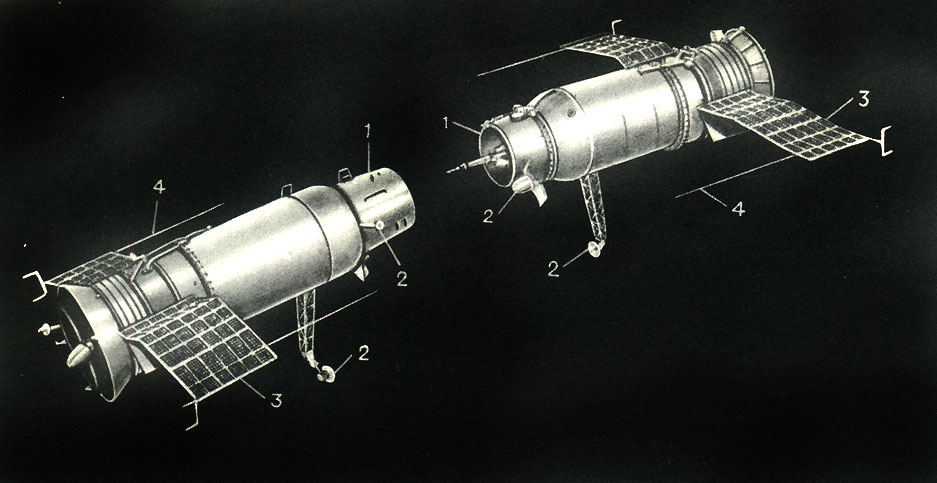 The secrecy of materials and censorship left many curiosities, probably the most famous of which is the image of the automatic docking “Cosmos-186” and “Cosmos-188” , urgently “drawn” by two engineers for a couple of hours for publication in the media. And when clarifying the value of the astronomical unit on April 18 and 26, 1961
The secrecy of materials and censorship left many curiosities, probably the most famous of which is the image of the automatic docking “Cosmos-186” and “Cosmos-188” , urgently “drawn” by two engineers for a couple of hours for publication in the media. And when clarifying the value of the astronomical unit on April 18 and 26, 1961 we should congratulate our colleagues on the planet. It surely wasn't Venus!
(We must congratulate our Russian colleagues on the discovery of a new planet. It was definitely not Venus!)
The closed nature of Soviet space research has generated a lot of myths in the West, where this topic continues to feed historians. For example, a snapshot of Anatoly Zack at last Spacefest VII last summer. The topic of his speech is Myths and Misconceptions around the Russian Space Program .

Facebook Emily Carney Photos
The interest in the memoirs led me to casual contact with two participants of those distant events, one of which (if precisely, then she), worked with Korolev, Babakin and told me many interesting details about how the AMC from the first Venus and "Mars" and to the last Phobos. And I talked with the second for quite a long time, unaware of his biography, only periodically marveling at his awareness of little-known facts from the history of Soviet cosmonautics, when suddenly the topic of conversation concerned this. In the end, he spoke about his work in the 70s-80s, which he once gave a subscription to non-disclosure of state secrets. It happened on April 12, 2016, when, in honor of the holiday, he showed several surviving artifacts and told several stories, one of which is in the title of this publication.
Please consider that this is just a publication of several photos that have never been published before, and which has grown somewhat at the entrance to finding out what is in the photo. Graphomania attack. Sorry)
Photos can be freely distributed. So to say, not to disappear historical artifacts of national history. Approximately for the same purposes “digital archeology” was one of my articles.
A follow-up study of “what did I take pictures of with him” led to amusing finds with which I will introduce you. The starting point will be this quote:
A similar photo has not received such popularity even in Russia. Although it was made by the Soviet Zond-7 automatic station on August 11, 1969. In fact, it was an apparatus based on the Soyuz spacecraft and its flight to the moon was part of the "lunar race" program. But the race was lost, therefore, apparently, the results of this work were not particularly spread.
Zelenyikot Earth through the eyes of an asteroid
This quote on the first photo on the left (CDPV) is a half-truth. A Google search for photos leads to a series of copies of an image that were once published at least several thousand copies. Perhaps pnetmon will find more. He well it turns out . )




Photo sources
Cosmos - to man . HELL. Koval, G.R. Uspensky, V.P. Yasnov. M., "Engineering", 1971. Circulation 15 000 copies.
Обложка журнала «Природа», 1971, №01-12. Тираж 41000 экз.
Ф. Боно. К. Гатланд ПЕРСПЕКТИВЫ ОСВОЕНИЯ КОСМОСА, 1975. Тираж 7000 экз.
Сокращенный перевод с английского под редакцией Г. Л. Гродзовского
Cильно подозреваю, что эта фото не попала в советский перевод из английского оригинала т.к. оригинал был издан во время полета «Зонда» — Frontiers of Space (The Pocket encyclopaedia of spaceflight in colour) Hardcover – London, August, 1969 by Phil Bono, Kenneth W. Gatland.
А почтовая марка же явно самый массовый пример.
А также:
ОСВОЕНИЕ КОСМИЧЕСКОГО ПРОСТРАНСТВА В СССР
Официальные сообщения ТАСС и материалы центральной печати октябрь 1967 – 1970 гг.
Москва, 1971 Тираж 4800
Варваров Николай Александрович
СЕДЬМОЙ КОНТИНЕНТ
М., «Московский рабочий», 1973
МЕТЕОЦЕНТР НА ЛУНЕ.
К слову на обложку этой книги попал другой снимок Зонда, оригинал которого можно увидеть в этом сборнике снимков — Земля глазами «Зондов».
On the first page of the dust jacket: Land, photographed by the Zond-7 automatic station on August 8, 1969, from a distance of about 70 thousand kilometers.
Обложка журнала «Природа», 1971, №01-12. Тираж 41000 экз.
На первой странице обложки: цветная фотография Земли; на четвертой странице обложки: цветная фотография лунной поверхности. Снимки сделаны «Зондом-7» из космоса. См. статью В. Д. Большакова и Н. П. Лавровой «Цветная съемка Луны и Земли из космоса») стр. 66.
Первый сеанс фотографирования Земли был выполнен 8 августа 1969 г. в 8 час. 52 мин., когда станция находилась на расстоянии примерно 70 000 км от нашей планеты. Станция была при этом сориентирована таким образом, что оптическая ось аппарата оказалась направленной на центр Земли. На цветном снимка Земли, отличающемся богатой цветовой гаммой, от светло-голубого до темно-коричневого (см. 1 стр. обложки журнала), хорошо видны моря Средиземное, Черное, Каспийское с заливом Кара-Богаз-Гол, Азовское, озера Балхаш, Иссык-Куль, Байкал. Отчетливо выделяются горные хребты Памира и Тянь-Шаня. К востоку, просветах между облаками, просматриваются горы Алтая. За границей сплошной облачности, затянувшей весь Кавказ, видны Черное и Азовское моря и Крымский полуостров. Севернее, за грядой облаков, просматриваются очертания Ботнического залива, Карелии и Белого моря. На южной части снимка — территория Ирана и Афганистана, Ирака, Малой Азии и Аравийского полуострова. За Красным морем видны пространства Северной Африки, долина Нила почти по всему его течению и, далее,— африканские пустыни.
В момент фотографирования линия терминатора (граница дня и ночи) проходила в Атлантическом океане.
Ф. Боно. К. Гатланд ПЕРСПЕКТИВЫ ОСВОЕНИЯ КОСМОСА, 1975. Тираж 7000 экз.
Сокращенный перевод с английского под редакцией Г. Л. Гродзовского
Фотография Земли, сделанная 8 августа 1969 г. с расстояния 70 000 км советской автоматической станцией «Зонд-7». В центре снимка — среднеазиатские территории Советского Союза. Южнее — не закрытые облаками пространства юго-западной Азии и северо-восточной Африки. В левой части снимка хорошо видны восточная часть Средиземного моря с островами Кипр и Крит, Эгейское море. За Пиренейским полуостровом начинается не освещенная солнцем ночная часть земной поверхности
Cильно подозреваю, что эта фото не попала в советский перевод из английского оригинала т.к. оригинал был издан во время полета «Зонда» — Frontiers of Space (The Pocket encyclopaedia of spaceflight in colour) Hardcover – London, August, 1969 by Phil Bono, Kenneth W. Gatland.
А почтовая марка же явно самый массовый пример.
А также:
ОСВОЕНИЕ КОСМИЧЕСКОГО ПРОСТРАНСТВА В СССР
Официальные сообщения ТАСС и материалы центральной печати октябрь 1967 – 1970 гг.
Москва, 1971 Тираж 4800
«Правда», 22 августа 1969 г. ТАСС: АВТОМАТИЧЕСКАЯ СТАНЦИЯ «ЗОНД-7» ФОТОГРАФИРУЕТ ЛУНУ И ЗЕМЛЮ
Варваров Николай Александрович
СЕДЬМОЙ КОНТИНЕНТ
М., «Московский рабочий», 1973
МЕТЕОЦЕНТР НА ЛУНЕ.
К слову на обложку этой книги попал другой снимок Зонда, оригинал которого можно увидеть в этом сборнике снимков — Земля глазами «Зондов».
God knows how many more copies could be printed - pocket calendars, magazines, newspapers, but not preserved for the digital age and are unknown to us. I managed to find out another case where this photo was copied. A feature of this case is that a copy was made once, but it was seen by thousands of people. This is the secret from the title of the article, which I would like to tell and show. Close to this case, a simple example suggested by Google search, and showing where such photos can be found:

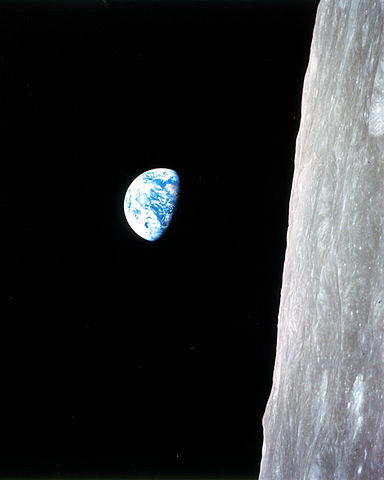
Something seemed? And so?


And for the complete collection:

We, not being witnesses of events, undertake to judge ancestors by secondary materials that have survived to our days. Not alive in that era, we undertake to judge, not having a complete picture of the world by the measures of our time, absolutely not understanding the emotions, causes and actions of the ancestors. Paying attention to details that they did not consider important and significant, and completely ignoring things important to them. It is therefore interesting to ask the opinion of the participants of the events themselves, as long as this is possible.
/**
Это не конец вступления, а конец лирического отступления.
*/I wanted to share the same light article as 22sobaki How the Moon was measured , lozga Silent step of the space future , with the conditional name “About the forgotten alternative energy”, where there would be photos of a unique Soviet object. Little-known, but almost completely preserved, but no longer fulfilling those functions, and which I was able to accidentally visit, as well as communicate with the retired engineer who once worked there.
Announcement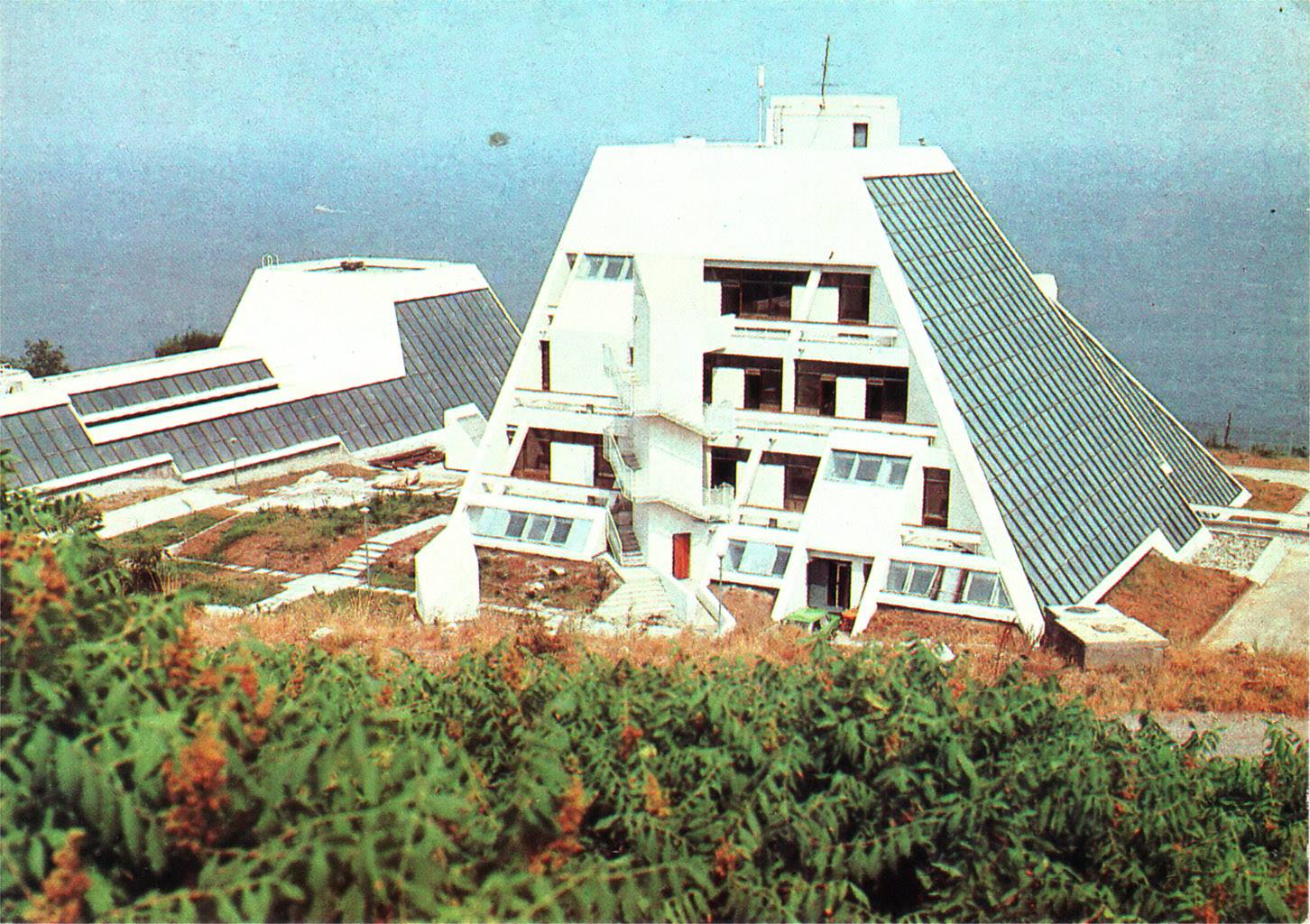

But this photo story for an indefinite period had to be postponed. Because On April 12, I unexpectedly received a priceless gift on my favorite topic. And I switched to it, and I will publish the photo of the object with the story later, if by that time in the GT comments I don’t get involved in a fight over disagreement on some issues of theology - something has recently melted karma. Yes, and the topic for some may be "religious and political." )
And so back to the topic. My narrator’s name is Sergey Pavlovich (hereinafter abbreviated to SP) and once he provided the transmission of Central Television reports from two Centers for Remote Space Communication (CDC) (NPC-10 and NPC-16 in the media were called CCDS, MCC, then just the Center - depending on the context, and in no case was information about their real location allowed. Here is an example of a fragment of an article about the Lunokhod in Ogonyok, where the journalist reported unclassified information about the real location:
... at the Center for Remote Space Communications. Although the sad bare steppe stretching to the horizon is only barely sprinkled with snow, and there are more and more Christmas trees. Yes, in general, this is not a Christmas tree, but small pines.
And about the neighboring MCC journalists reported something like this:
Huge eight-headed receiving antennas trembled and smoothly raised their bowls. It became quiet in the spacious halls of the Center, so that it seemed as if blue-green snakes were pulsing signals on numerous screens, which now have the attention of operators. The creators of the station bent over the graphs and columns of figures, checking their calculations with the data displayed on special boards. Only the frivolous morning chirping of birds was added to the rare short messages on the loudspeaker line, and a purely earthly note broke into the strict concentration of the premises of the Center, where the world of distant Venus reigned today.
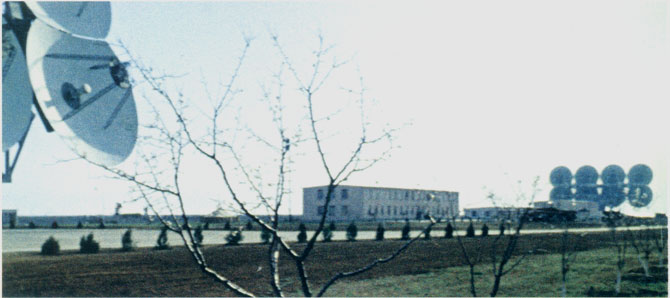
Last summer, this building looked like this (specially planned to drop in here to see what changed there after the events, the anniversary of which was celebrated yesterday. Externally - new antennas appeared on the territory):

The console glows with colored lights — blue and green pulses are running on the oscillograph screens.
- Tick-tick, tick-tack — like a metronome, a device clicks. Slowly time passes. Expectation. Concerned faces.
Tik-tik, tik-so. For a long, long time is the signal After all, he will have to run 78 million kilometers. 4 minutes 20 seconds will go to this ... Yes! There is!
In the hall, where journalists sit, a long screen in the wall. It shows the station’s entry into the atmosphere of the planet. Below, to the left, on the outermost screen of the oscilloscope, the blue rhombus of the onboard radio transmitter signal pulses. Above, the numbers counting seconds and minutes of Moscow time are rapidly changing. “According to the updated data, the time of entry into the atmosphere — 7 hours 58 minutes 44 seconds — is announced along the speakerphone line — the estimated time of the signal loss is 8 hours 02 minutes.”
Hooray! There is a signal. As if a sea of smiles spread around the room. Everyone is happy. Congratulate each other. The signal is strong, good. It is only five times weaker than what a directional antenna gave. Now the blue ray of the oscilloscope records information that astronomers have dreamed of for centuries. Radio signals will inform the Earth about the pressure, density, temperature of the atmosphere of the most mysterious planet of the solar system.

And this is how this “neighboring TsUP” actually looked like, from where Soviet spacecraft were controlled - (described according to S. P.) a fragment of a hall with a number of operators' workstations along the wall, a computer terminal (seemingly to “Minsk-22”) and on the wall is a large digital display (the very Nixie-indicators, as they say now) with the parameters of the spacecraft. Picture taken after work. Therefore, everything is turned off in the photo and in the frame only an employee of the television is at his control (you can see a microphone, a video monitor). This is the only photo of the “Center Hall” known to me.
In 1975, the Mission Control Center near Moscow was commissioned. In the fall of 1977, the new Salyut-6 station (DOS No. 5) was already operated from the new MCC. The stage of regular long manned flights began from this station in the space program. The flight management service has been reorganized. Instead of a semi-partisan gathering, similar to a Cossack army, a professional service with a clear structure of responsibility and separation of functions among stations, ships and shifts was created, consisting of several hundred specialists from different tribes going to the Black Sea.Chertok B.E. Rockets and people. Book IV. Chapter 19. People in the control circuit
The formation of the professional flight control service, begun by Tregub, was completed with great enthusiasm by Alexey Eliseev. He was credited with creating a clear structure and strict responsibility scheme at the stage of preparation and conduct of the flight. LOCT as a temporary interdepartmental organization gradually died off. Since 1974, its functions have actually been performed by the flight director, an astronaut, a representative of TsKBEM, NPO Energia. The first was Alexey Eliseev. In 1986, Valery Ryumin replaced Yeliseyev in this post, and from 1988 to the present, Vladimir Solovyev has headed the service.
The first generation of managers recalled the Evpatoria Management Center as a lost paradise. The Black Sea, kilometers of wild sandy beaches, a steppe covered in spring with scarlet poppies, cheap dry wine, grapes, fruit, a caressing sea breeze - all this Crimean romance was a thing of the past.
S.P. he also recalls this time in the MCC with a large amount of local alcohol and ... women's attention (corrected by censorship), if his stories are reduced to two words about what business travelers were doing in their free time. Business trip to the resort in essence. Sometimes for a couple of months.
/**
Здесь заканчивается вступление, которое не планировалось. Переходим собственно к самому материалу.
Спасибо, что Вы с нами. Не переключайтесь!
*/Artifacts S.P. - This is a few photos that have survived to our days. The rest was lost because not really appreciated.
For weeks, working at the MCC (in this case, Evpatoria is meant), often intersected with astronauts and, of course, took autographs. Interestingly, the “Central Television Studio in the MCC” from where there were broadcasts to Central Television in Moscow and further throughout the USSR: interviews with cosmonauts, specialists, the latest space news, etc., according to S.P. It was a small room in one of the buildings. S.P. proud to work with famous Soviet TV journalist Yury Fokin(who remembers him now? I first heard about him from him), considers him a brilliant and talented journalist. Of the interesting things about him, I remember the tradition of the first thing after arriving to buy a bottle of local Calvados, which he loved very much and during the business trip he gradually drank a bottle himself. He speaks neutral about other TV journalists, believing that in the 1980s the class fell and even slipped into yellowness (this is about Zheleznyakov , whom he considers random in this subject, who came to the space theme just for a quick career, not “love of art”) .

Cosmonaut Alexei Stanislavovich Eliseev , who was in charge of orbital stations at that time.

Completion of work was marked by such “souvenirs” - “express reports” made in a photo lab (the first thought was how much simpler life was with the invention of Photoshop and photo printers):
Express report on the work of Venus-9.

There was another one on the Internet - about the Venus-9 and Venus-10. An

express report on the Salyut-5 and Soyuz-21 orbital stations.

And Soyuz-24.

In the Soviet documentary film about the Moscow TsUP, at 15:36, you can see a wall with such photo applications.

Later he accidentally found earlier versions in his memoirs, made with a somewhat simpler technique. And then, after the photo, leaf through the “Exhibition Catalog. Alexey Leonov, Andrei Konstantinovich Sokolov. Painting. Graphics. ”Publisher“ Soviet artist ”, Moscow, 1984.
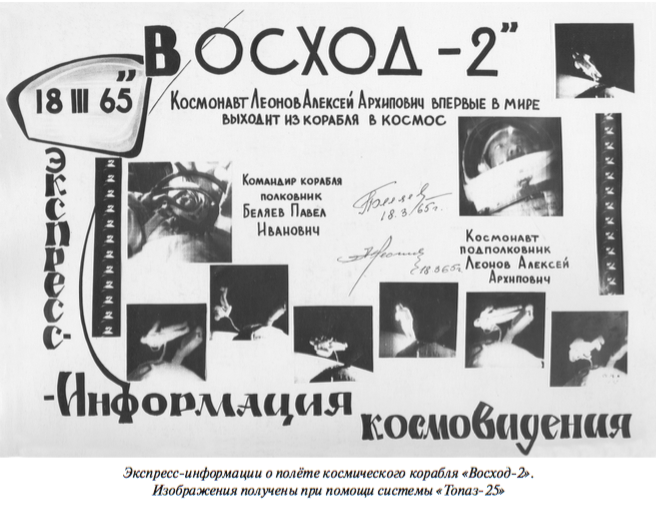
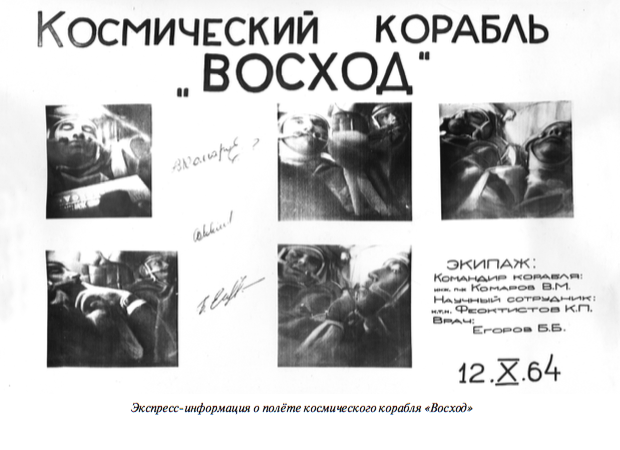

Once I found a site dedicated to the works of A.Sokolov and A.Leonov , scifiart.narod.ru I spent several days on it. And one of the impressions of the paintings were the views of the surface of the Earth, which the artists have succeeded well. And he noted for himself that now it is much easier to draw - from Google Earth to online cameras on the ISS and all without leaving home.
Several photos with description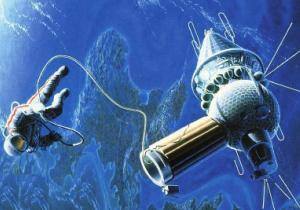
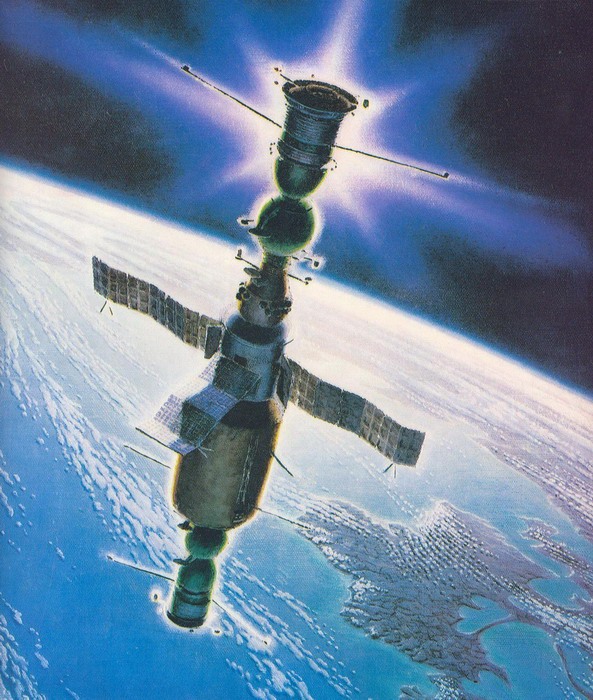
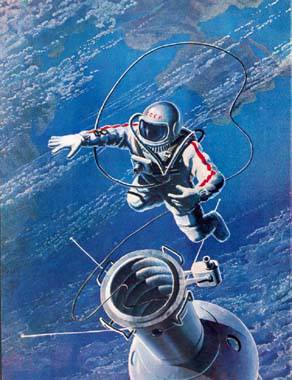
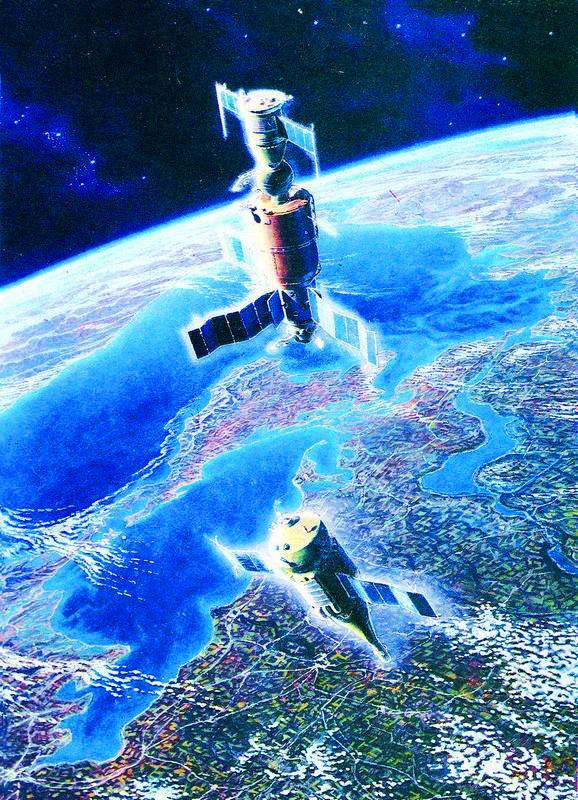

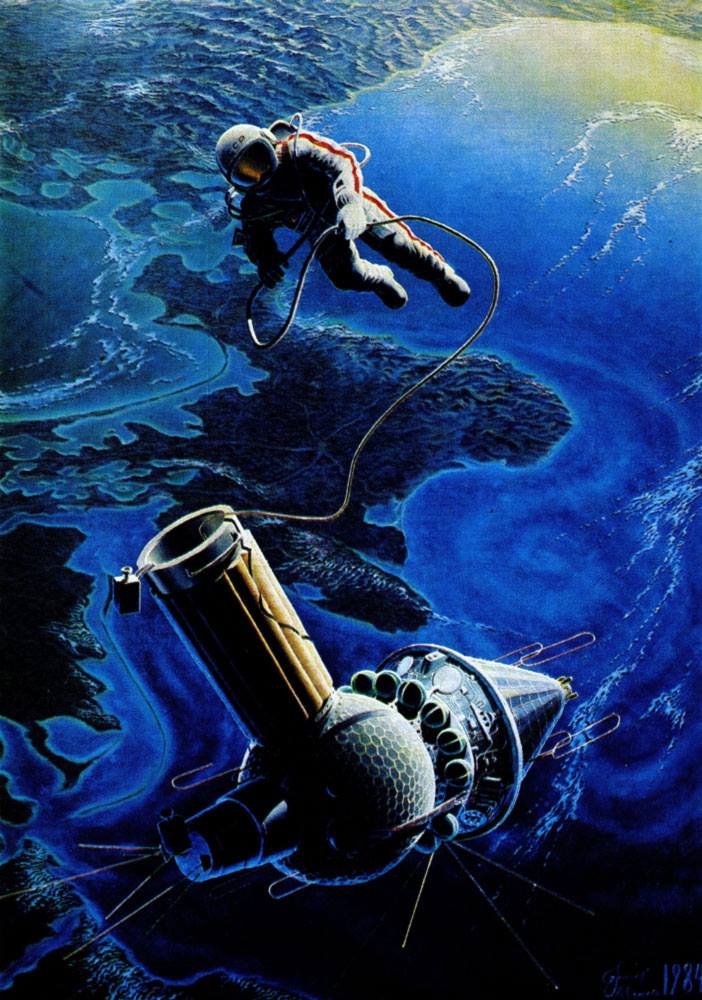
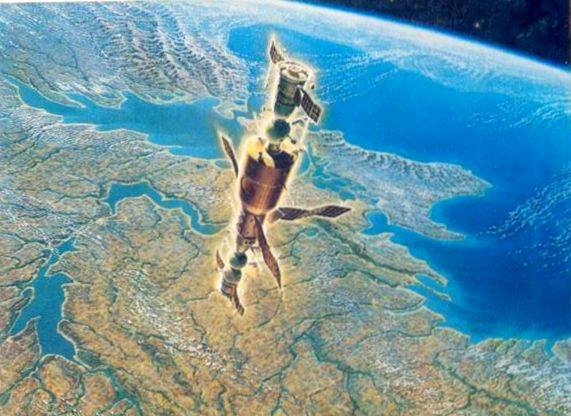
Над Аралом:
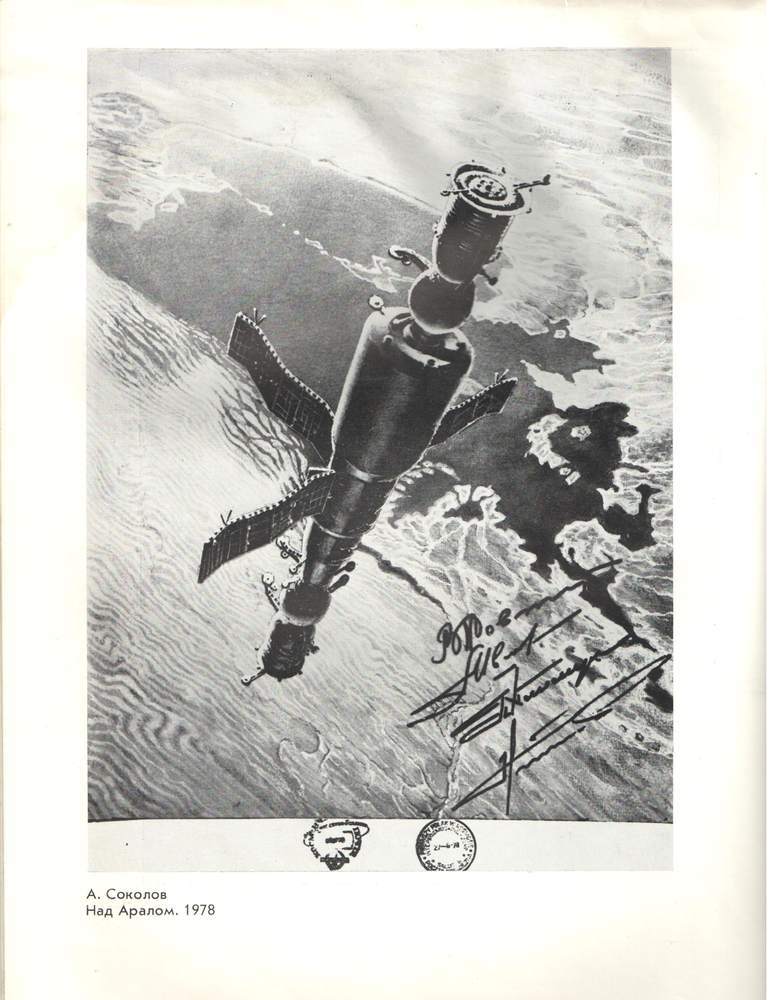

А.Леонов парящий над Крымом в тот момент, когда он вышел из шлюза.

А. Соколов ОРБИТАЛЬНЫЙ КОМПЛЕКС НАД ЧЕРНЫМ МОРЕМ
На картине показана картина заката нашего светила над Черным морем с учетом замечаний, высказанных художнику летчиками-космонавтами В. Ляховым и В. Рюминым. Художник изобразил орбитальный комплекс «Союз» — «Салют-6» — «Союз» в момент, когда он закрыл собой заходящее солнце.

В КОСМОСЕ из альбома «Космические дали». А. Леонов, А. Соколов. На картине изображён Алексей Леонов, 18 марта 1965 года вышедший в открытый космос

А.Леонов, А.Соколов. «Над Донбассом». 1984г.

Картина Алексея Леонова «НАД ЧЕРНЫМ МОРЕМ».
18 марта 1965 года. Московское время 11 часов 34 минуты… Радио доносит из космоса голос командира корабля «Восход-2» Павла Беляева:
«Заря! Я — Алмаз! Человек вышел в космическое пространство! Находится в свободном плавании!..»
Свершилось! Впервые в мире человек — советский космонавт Алексей Леонов в открытом космосе, лицом к лицу со Вселенной. Осуществлен важнейший шаг на пути покорения космического пространства. Перед вами необыкновенный, но вполне реальный «автопортрет» космонавта А. Леонова. Он изобразил себя парящим над Землей в тот момент, когда вышел из шлюза космического корабля в открытый космос. Это было над Черным морем.

А. А. Леонов, А. К. Соколов. Люди грядущей планеты. Левая часть триптиха. 1984

Из набора открыток КОСМОС НАРОДНОМУ ХОЗЯЙСТВУ, 1985.
«Над Землей — орбитальный космический комплекс, в составе которого станция „Салют“ второго поколения с двумя пристыкованными к ней кораблями „Союз-Т“. Один из них доставил на борт станции экспедицию посещения, и теперь совместно с членами основного экипажа космонавтам предстоит выполнить обширную программу научных исследований и экспериментов.
Над Аралом:

Leonov flew only twice in 1965 and 1975.

This catalog has clarified the question of how artists worked on paintings, because any artist needs a “nature”:
Sokolov first addressed his theme in art in 1957.
In 1961, a picture by A. Leonov appeared in the newspaper "Pravda" with a comment by Y. Gagarin. In 1965 there was an acquaintance of Sokolov and Leonov, and now their creative collaboration continues for twenty years.
Each of Sokolov's canvases, even seemingly on the same plot, is unique in its own way. Especially interesting are the pictures, the sketches to which we visited in space and were corrected on board the modern orbital stations Salyut-6, Salyut-7: “Above the Aral Sea”, “Above the Black Sea”, “Above the Gulf of Mexico”, “Above Caspian. Here, for example, that cosmonauts V. Lyakhov and V. Ryumin wrote on the sketch for the painting “Above the Caspian Sea”: “It (the sketch. - M.V.) corresponds closely enough to nature. This drawing is more like twilight at sunset. There must be cloud shadows. ”
In the sketch for the picture “Over Florida”, the comments of American astronauts: “It looks very realistic, except for the clouds in the lower right corner in the form of too straight lines that are not quite true, and the purple color at the upper edge of the air halo is too purple and too bright. Michael Collins. “Very realistic! We can almost see our launch pad. Owen Garriot. “Made good drawings! The surface of the Earth is not covered by clouds, more colorful, similar to that seen from an airplane. Alan Bean.
There are many such sketches with adjustments, and they serve as an illustration of how it is not easy, with what exactly verified objectivity he creates his paintings.

(The bottom half of the sheet shows a photocopy of the handwritten commentary with comments on the sketch of the painting Ukraine (1982) made by the crew of the Salyut-7.)
Comment in high resolution.
Внимание! Ошибка! Рисунок сделан с высоты менее 200 км.
Очень много красного и светло-жёлтого и мы видим намного больше чем нарисовано. Больше выражены реки и складки местности. На горизонте нет чёткости, а только дымка. Ближе всё чётче.
Владимир Ляхов. Александр Александров. Борт Салют-7.

Внимание! Ошибка! Рисунок сделан с высоты менее 200 км.
Очень много красного и светло-жёлтого и мы видим намного больше чем нарисовано. Больше выражены реки и складки местности. На горизонте нет чёткости, а только дымка. Ближе всё чётче.
Владимир Ляхов. Александр Александров. Борт Салют-7.
Leonov's picturesque works are somewhat different, less abstracted. They contain a clearly formulated concrete plot and its no less clear embodiment: “Automatic docking”, “In open space”, “Orbital station“ Soyuz-Apollo ”,“ Cosmic radio bridge ”. These works are distinguished by accurate knowledge of the subject, reliability, persuasiveness. Leonov made sketches for his paintings during his flights into space. They can be found on the pages of the logbook "Voskhod-2" and "Soyuz-19". Interesting graphic sheets Leonov. Apparently, the drawing is closer to the cosmonaut-artist.
Toward the end of the album a color photo was attached. It was originally glued to a piece of cardboard, but over the years, some edges have come off. Of course the photo immediately attracted attention.

For publication I “pulled up” the colors, otherwise it is hard to see in this photo. S.P. commented: “Taken by Zond. And printed in the photo lab at CDC on Kodak photo paper. ”
But the spread of the directory. The photo is stored here for a reason.

On the right of A.Leonov's graphic “In flight Molniya-1”, which could not be found on the Internet in good resolution, therefore: S.P. drew my attention to this part of the graphics:
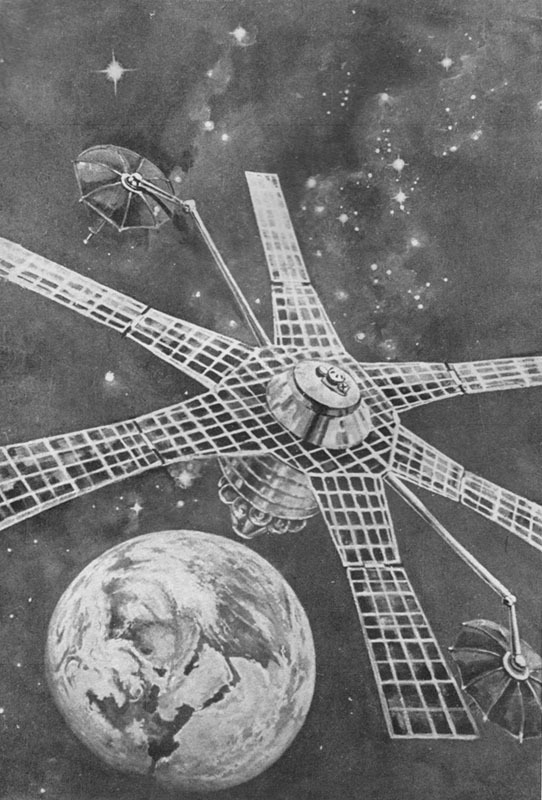


It can be seen that the photo “Zonda”, the key parts of which are depicted on the chart: Asia Minor, the Balkans, the Black Sea with the Crimea, the Arabian Peninsula and the Persian Gulf, half of the Caspian Sea and the still-flowing Aral Sea, became “in kind” for the artist. You can not see only a giant spot, which is located in Egypt and could be Lake Toshka , but in fact some kind of defect in printing or photo storage.
Scan of this photo:

And a snapshot "from the Internet":

As a result:
Returning to the image and quotation at the beginning of this text, we can say that in fact it is true that the photo gained popularity, but often as part of another image, hiding its origin of the uninitiated. At the same time, it was interesting to learn how the artists worked on the pictures of space subjects.
/**
Здесь должна была закончиться публикация, но....
*/With this I planned to finish, but the story had a sequel. Seeing my admiration, SP a few days later I found and showed another artifact. Photo of the crater on the far side of the moon. On the back of the photo there is an inscription, the name of the photo and the apparatus that removed the crater. Last I pasted on the image. Unfortunately, the photo was exposed to water, the ink blurred and it was impossible to say exactly which machine the crater took off. My first thought for some reason is that this is an unknown snapshot of Luna-11. It was not possible to find photos on the web - apparently the photo has never been published. But the inscription on the reverse side, after editing the image levels, clearly contains the letters "Zones". Most of all this is similar to „ Zond-8
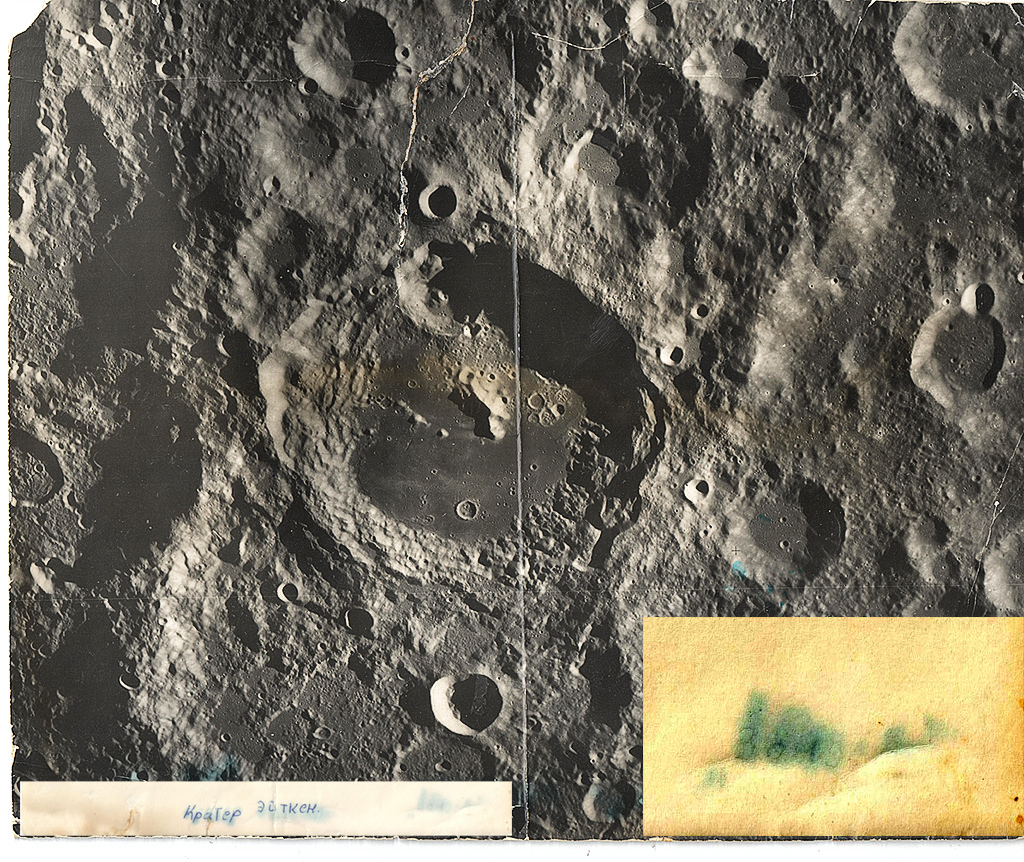
“Photographed the moon in 1970. And S.P. claimed it was probe-8. Although in this state it is difficult to distinguish "3" from "8". I believe in the word. Moreover, now the origin of the photo has recently been confirmed to me by another photograph of Zond-8 from the private collection.
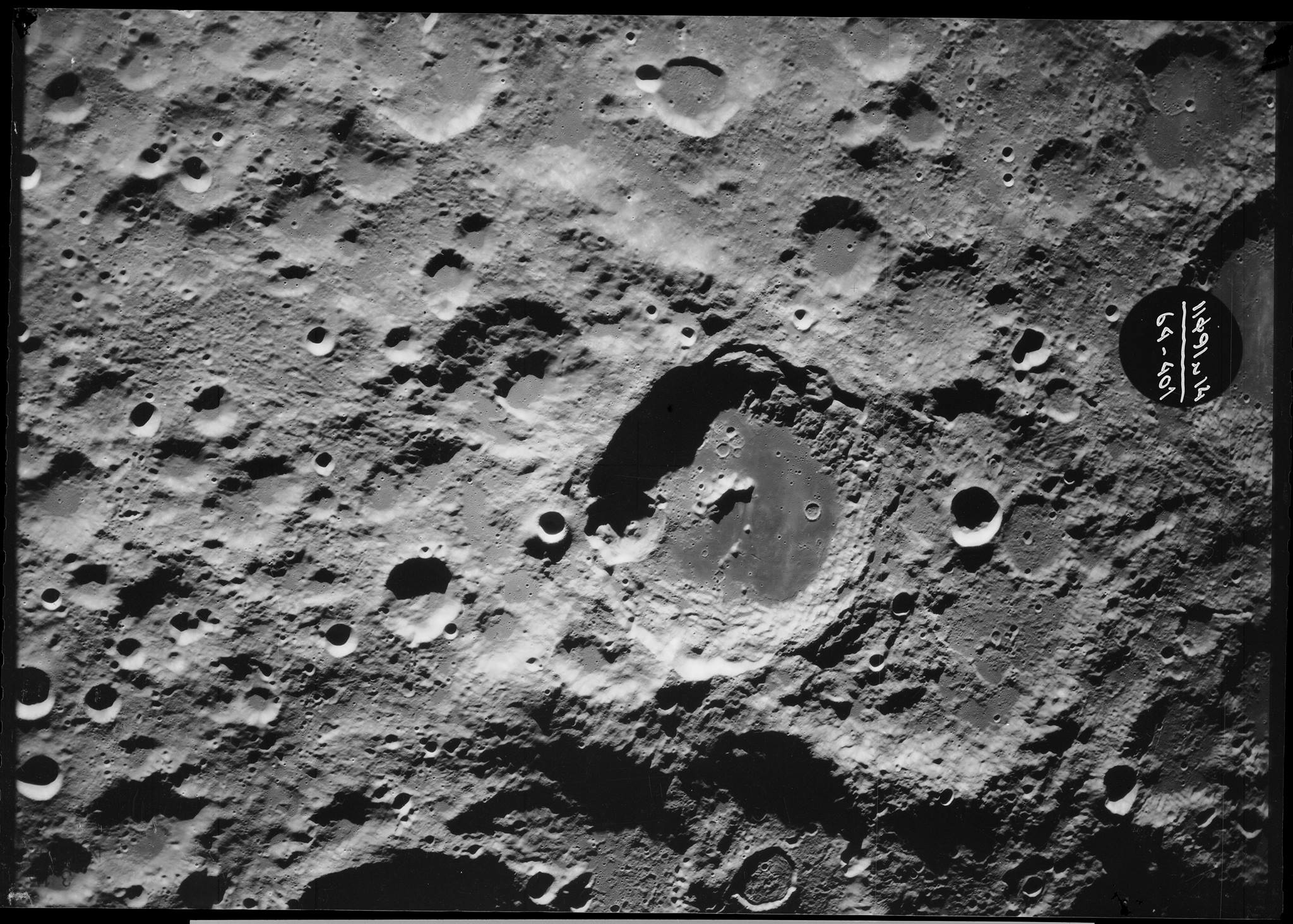
The reverse side of the photo is completely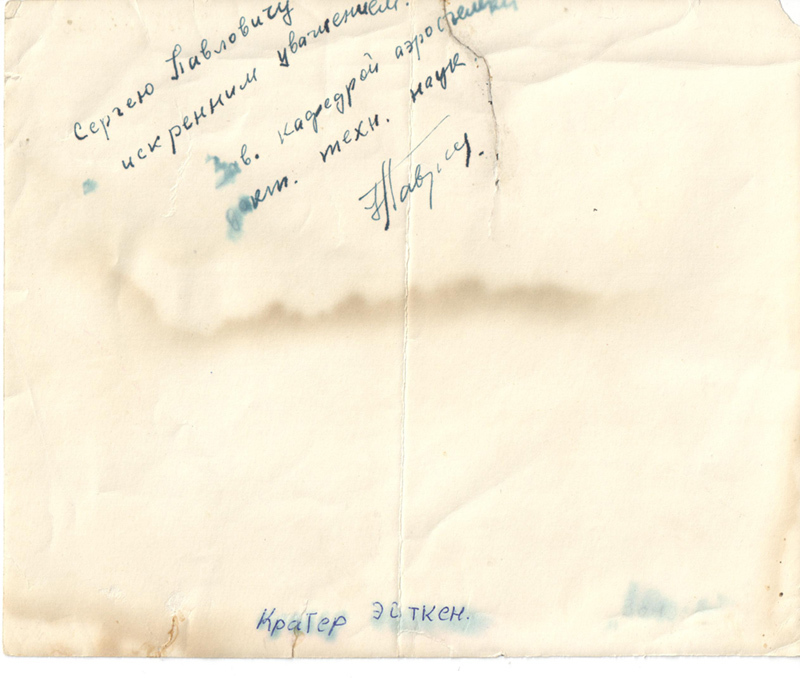
Возможно Лаврова Надежда Павловна
С 18.03.1968 г. по 19.06.1989 г. Н.П.Лаврова возглавляла кафедру аэрокосмических съемок МИИГАиК. Участвовала в организации и выполнении работ по космическим съемкам Земли, Луны.
По научным программам МИИГАиК, в которых принимала участие Лаврова И.П., получены первые снимки Земли с окололунной орбиты при полете автоматических станций «Зонд».

Возможно Лаврова Надежда Павловна
С 18.03.1968 г. по 19.06.1989 г. Н.П.Лаврова возглавляла кафедру аэрокосмических съемок МИИГАиК. Участвовала в организации и выполнении работ по космическим съемкам Земли, Луны.
По научным программам МИИГАиК, в которых принимала участие Лаврова И.П., получены первые снимки Земли с окололунной орбиты при полете автоматических станций «Зонд».
First of all, it became interesting: what is Aitken crater, where is it located, why is it called, and when is it named?
As it turned out, Aitken crater is indirectly well known in connection with the South Pole Basin - Aitken . And in the English Wikipedia article dedicated to the crater Aitken . The crater is located on the far side of the moon (16.8 ° S – 173.4 ° C), on the northern side of the giant crater. Named in honor of the American astronomer Robert Aitken (1864-1951). The crater has a diameter of 135 km. The crater was photographed in 1972 by the crew of Apollo 17. The name was approved by the International Astronomical Union in 1970. Probe-8, I remind you, flew in October 1970. Who offered to call him so - I could not find. Maybe this photo is the first photo of the crater in the history of mankind and was taken when it was still nameless.
The fact that the race was allegedly lost, therefore, apparently, the results of this work were not particularly spread ( Zelenyikot ), does not mean that the work was simpler and easier.

("When you are number 9, you try harder" - referring to the famous slogan of the American company, which ranked second in the market in its niche: "We
try harder because we are number two". // We try to work harder because we are number two.
In rephrasing it is used as “If you are number two,
// If you are number two, then you just try (to work) harder.) The
results were no less important than those of your rivals in the space race, and which can be admired 50 years later. But this photo raises an important question - where are these results now ? On Geektimes there is an excellent article " Flight to Venus and Mercury, or we sort and sort RAWki 40 years ago ". You can envy such an approach to its history. In many ways, this is a dream for national history.
Will be published domestic photos? I doubt it, at least in the coming years. S.P. about this crater shared memories of a conversation in those days about these photos with experts - that if the photos were something that can not be explained, then the photos were classified. The possibility that the United States could secretly carry out work on the surface of the moon was seriously assumed. Photo publishing would allow the United States to find out that their object could no longer be so secret for the USSR and take some measures.
Declassification of what has not been interesting to anyone for a long time is still a problem now. Easier to destroy. Well written about this in this quote from the memoirs.
Today, at the astronauts' house, a regime officer stopped me. I was warned that if I am going to write to a newspaper on any topic, then the text must first be coordinated in a special commission of the Center.
It turns out this is a whole procedure. Here is a sample of the document to be compiled and agreed upon in order to have the right to send a note to the newspaper. Let it be even a few lines.
First, it is necessary to compile the author's certificate, in which it is necessary to indicate that there is no secret information or similar information in my text. My signature must certify the command of the Center. This is my guarantee.
Secondly, it is necessary to fill in and sign with the members of the commission an “Act of examination of materials prepared for open publication”. The act to approve the unit commander (head of the Center).
The correctness of each item of the act must be proved to each member of the commission and the commander.
So now I understand those soldiers who do not want to get involved in the press.
Vasily Sergeyevich Lesnikov “Next to cosmonauts. American time. 1970-1979 "
As far as I know, approximately since 2009, control over the regime and a trickle of what was half-legally from the archives, museums of the military-industrial complex factories, and in the media in the 2000s dried up again. And no one has a desire to contact the official procedure for declassifying and publishing materials (in fact, this is voluntary, the work is not funded, and responsibility is taken).

(Photo by Luna-16 from a private collection. In the foreground is a stereoscopic system for forming a panoramic image, which included two panoramic scanning cameras of 3,000x6,000 pixels of the same type that stood at the early landing stations of the E-6 series and lunar rovers. Located on the landing gear directly under a return missile on the same side as the sampling system, they were separated by 50 cm, covering a field of view of 30 °.)
Since the second half of the 2000s, thanks to the widespread Internet access, a large amount of information, memories, historical photographic and video materials has appeared. Then there was information on the subject of Lunokhod that was interesting to me, and if by the end of the 2000s there were only a few remarkable publications in newspapers and TV stories, now a large amount of documentary materials are available, interviews of participants and publications for different years. But some details in the publications do not pay attention. For example, there is practically no detailed technical description of both the consoles and the lunar rover itself. In general, the scheme of the transmitter of the first Satellite in the network appeared quite recently. Apparently a big secret.

I wonder if something turned out at maxgorbunov ?
Thank! Yes, that is right. In connection with the article, I talk with the representative of the leadership of the RKS: maybe it will be possible to make public the materials on the first satellites.
While the state is not going to finance the publication of historical documents, the interested people are “ready to buy.” And sometimes you can officially buy something - I find very interesting pictures about the history of astronautics and technology of the USSR in the photobank Sputnik (VisualRian). The only thing that the signatures may contain errors, and the photos themselves are mirrored.
This sadness is brightened up by private initiatives - history lovers who, with their money and free work, “extract”, store and publish historical materials. For example, they raise money for digitizing Soviet space films from film archives (there are these comrades, for example, on rutracker with distributions). An important job at their own expense in preserving space history is done by the owners of the epizodsspace.no-ip.org resources .(http://epizodyspace.ru) and www.kik-sssr.ru . There is an example on Geektimes Shubinpavel We process forgotten pictures from a forgotten lunar station . Most of the Soviet space photographs, the panoramas of Venus were generally in digital form due to personal means and the great desire to get these photos of one person. A former Microsoft programmer from Redmond in the early 2000s found contacts and paid for digitizing Soviet images stored at the Space Research Institute, if I'm not mistaken. Pictures were used when writing articles on his website . In reality, he has more photos than published, and a photo with his “credit” and in its processing can be seen in popular science books and various thematic sites.

Page # 382 from the book “Infinity Beckoned: Adventuring Through the Inner Solar System, 1969–1989”
Unfortunately, this is not all originals, but most often a reprint is not the first copy and also a paper copy. Although there is definitely digital originals somewhere. Unfortunately, besides bureaucratic obstacles there may be technical ones.
Find out why
Скорее всего хранятся цифровые копии даже не на 8'' дискетах, а на лентах в формате данных для какой-нибудь ЕС. Вопрос «чем прочитать» есть и у НАСА.
Вот такая публикация мне случайно попалась на глаза в старом советском журнале:

Где-то хранятся и более современные цифровые данные. Комета Галлея. Вега-1:


Вот такая публикация мне случайно попалась на глаза в старом советском журнале:

Где-то хранятся и более современные цифровые данные. Комета Галлея. Вега-1:


I will touch on the favorite topic of moon rovers and start again with a quote from Zelenyikot from the St. Petersburg Cosmic publication :
It would be cool to “resurrect” the console: change the monitor, load into it some kind of a rover / moon rover simulator, and give visitors the opportunity to control the legendary device, albeit a virtual one. In the meantime, you have to rely only on your imagination.
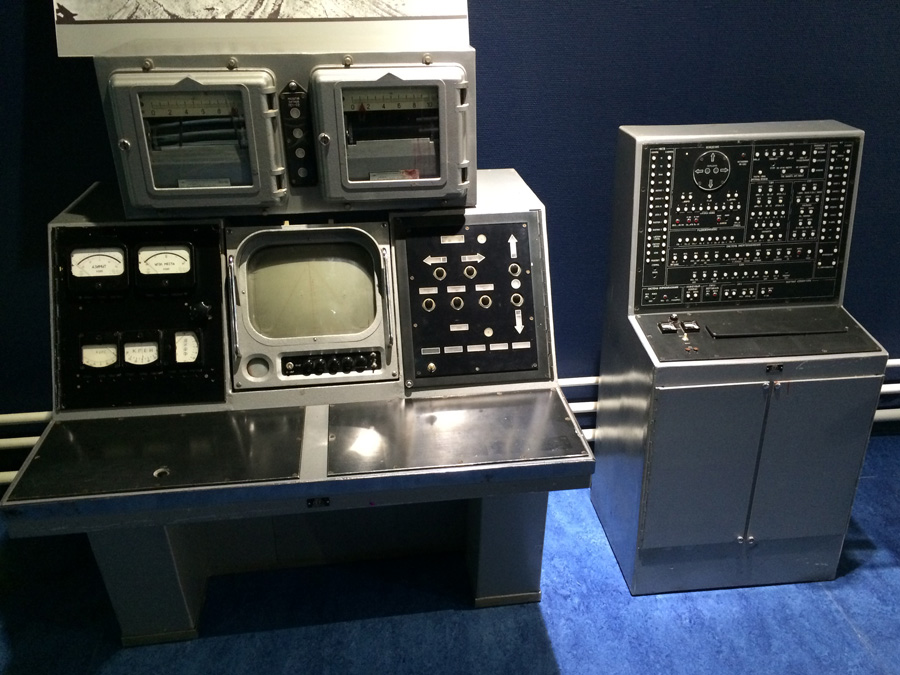
To control with the help of this remote control is possible only with the directional antenna of the lunar rover. This is not obvious to museum visitors. the caption to the exhibit is approved by the “Fragment of the Lunokhod-1 control panel”. And this is in the museum, where it seems as if they should know the history of the exhibits more deeply.
Some things are not described anywhere, perhaps the authors of memoirs or studies did not particularly think about some details. And the only ones who can tell about it are living witnesses of events. Unless of course ask them about it. What I asked S.P. because He participated in providing live broadcast of Central Television from the Lunokhod Control Center. So it looked for viewers and readers of the Soviet press.

And so it was really:

By the way, the direction of the shooting is due to the fact that there was nothing secret in the frame.

The modern look of the lunodrome from about the same place and in the same direction:

According to S.P. This is one of the first Soviet television cameras for outdoor shooting. The camera itself weighed about 60 kg and about the same tripod. The camera was connected by more than a kilometer cable to their mobile television studio (PTS), with which the directional antenna transmitted the signal to the television center antenna and the relay communication line to Moscow. Memories of how they dragged him on his lunodrome are fresh.
In a recent interview, V.Dovgan said that the joystick was called a “joystick” (knüppel), as it turned out, the word familiar to the military of some specialties and military-industrial complex engineers, and transferred from them to “civilian language” in the era of the emergence of personal computers as a local competitor to the word “ joystick". He also told a little about how he managed - the joystick was set to the required position and a button was pressed at the end of the handle, confirming the sending of the command. But there is no information about the remaining details of the consoles.
I was interested in several questions for a long time: the handles on the video monitor, the round indentation below and to the left of the screen, the device to which the commander points in the picture with a finger, the flat device standing on the left side of the driver’s console, and many more small things in the photo and film shots.

TV crews worked with the crew and at the Lunokhod control point. Thanks to S.P. I was explained the purpose of the details in the photographs of the remote controls of the moon rover. And by the way, the TV people worked not only there. S.P. said that the hotel room in Ukraine (Simferopol) with the drivers of the Glory and Gena lunar rover was very conveniently located near the buffet. Communication was not interrupted for a long time.

On the left panel of the commander’s console there is only one device, which turned out to be for hours. And the flat device with a thick cable on the left side of the driver’s console turned out to be an indicator of the number of a television frame.

The rest of the points above i were arranged by the book of the driver of the lunar rover V. Dovgana Moonlight Odyssey of the Russian Cosmonautics. From the "Dream" to moon rovers.. In particular, it turned out the number of the television frame and the time imprinted on the film. Such as EXIF and teleframe archiving. Do they ever digitize them all? I would like to see with reference to the terrain, for example, in Google Moon.
Vyacheslav Dovgan, in fact, the only source of memories of lunar rovers. His interview, publication is actually the only thing that can be found. His book summarizes and clarifies a lot of scattered information into a single picture. Refutes the speculations of the yellow press, describing how events actually happened. Although the consoles and jobs Vyacheslav Dovgan and not described in full. White spots in these issues S.P. erased simple answers.
The microphone and the box with the slits of the loudspeaker under the phone - speakerphone. Dovgan writes that at first they tried to work with headphones - it turned out to be inconvenient.


Two handles on the monitor - the monitor turns out to be a separate device that simply lies on the “carriage”. In the event of a breakdown, it was quickly picked up with two handles and replaced with a spare. And two pens because it was lifted by two people - the monitor weighed about 30 kg, about half of the mass falls on the supply transformer.

And finally, “the handles on the video monitor, the circular groove below and to the left of the screen” - the handles are the usual television picture settings. A “round groove” turned out to be another screen — an oscilloscope showing the presence of a signal. Because the picture on the video monitor screen was rarely updated, then the osciloscope made it possible to immediately understand that something had happened and there would be no next picture.

That's all.

